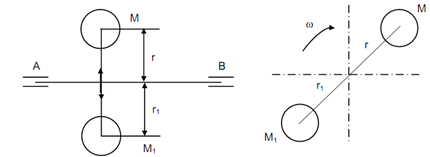Balancing of a Single Revolving Mass:
In the system, balancing is a procedure of the redistribution of the mass such that the reactions at the bearings are in the tolerable restriction of the bearings. There are two methods of attaining this.
First Method
The influence of an off-axis or eccentric mass linked to a rotating shaft, as brought out above, need to be nullified. One simple way by which this is attained is by associating another mass M1 at a radius r1, exactly opposite to M as illustrated in Figure 2. The shaft is rotating at an angular speed of ω.

The mass M1 and its radius are so selected that the centrifugal force on this is F, that means.
F = (M/ g )ω2 r =( M1 /g) ω2 r
which means that
M r = M1 r1
If Equation (5) is satisfied then the resultant force on the shaft and therefore on bearing shall be zero. Therefore additional reaction or overload on the bearings is zero and BM = 0, therefore no additional stress in the shaft shall be induced. Now the system is known as internally balanced. Internal balance is attained by adding up a balancing mass exactly opposite to revolving mass that causes unbalance. Therefore the disturbing and balancing masses (W and W1, respectively) are in the similar plane for internal balance and they satisfy the condition given by Equation. This method is utilized for balancing wheels, etc.